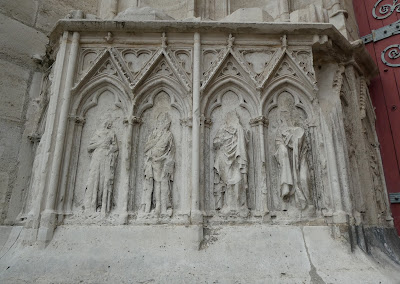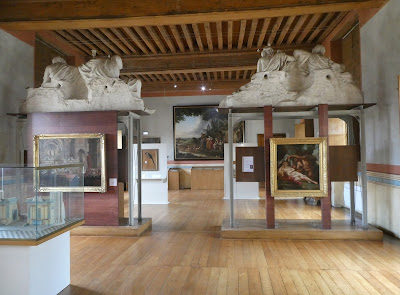We had company on July 2 at our "wild" mooring (a quay, but no bollards or rings, so Lon had to drive mooring stakes for our lines) in Montereau-fault-Yonne. The lovely folks on the barge Csavargo, also members of the barge association we belong to, are, like us, headed to the rally in Auxerre. We first met them (briefly) last year in Compiegne, then re-introduced ourselves when they ended up in the Arsenal in Paris for a couple of days. We met again several days later at the mooring in Moret-sur-Loing. Over docktails on July 2 we realized that our cruising schedules would align on July 3 and 4, so we cruised in tandem on those days.
 |
| Our July 3 cruise to Pont-sur-Yonne included a rainy morning. It's been a while since I've needed the heavy-duty rain gear. Here we are sharing a lock with Csavargo. |
Our stop for that day was the small town of Pont-sur-Yonne (literally, "bridge on the Yonne"). The town had two nice mooring pontoons across the street from a boules (a game similar to bocce) court. A quick stroll through this medieval town revealed the requisite collection of historic monuments (one of the oldest gothic churches in France, remnants of the old town fortifications, timbered houses), but not a whole lot was going on except for a few boules games. Janos and Rachel and Lon and I played a quick game of boules, retired to the back of CARIB for docktails, then called it an evening.
The July 4 cruise to the city of Sens was relatively short, but not without its moments of excitement.
 |
| The exterior of the cathedral. With only one tower, it seemed a little "lopsided" to me, but the north tower was removed during renovations in the mid-1800's and not replaced. |
 |
| The interior of the cathedral. Not as soaring as some cathedrals, but as it was the first cathedral of its kind, it was left to the builders of future cathedrals to reach for higher heights. |
 |
| As in the church in Meaux, the resident stone saints surrounding the exterior door have "lost their heads". |
 |
| The monument for the Dauphin and his wife. |
 |
| The former Archbishop's Palace, the age of its various wings ranging from the 13th C to the 18th C. |
 |
| The Grande Rue of Sens. |
 |
| The fabulously ornate Town Hall (Hotel de Ville) from 1904. |
 |
| These 13th C walls and tower incorporate at their base the only remaining bits of the 3rd century Roman walls that used to encircle the town. |
 |
| Abraham's House was built in the 16th C for a tanner. Its corner post bears the intricately carved "Jesse's Tree", representing the Virgin and eight kings of Israel. |
We're not always museum afficionados--most times we enjoy just doing walking tours around a town--but we were really impressed with the Sens Museum. Spread over four levels in the former Archbishop's Palace, it lays out the culture and heritage of Sens from: Prehistoric and Celtic artifacts; the Roman period of the first through third centuries; paintings and sculpture from the past 500 years; and last--but definitely not least--items from the Cathedral treasury. The latter is one of the richest treasury collections displayed in France.
 |
| The oldest of the archeological finds from the region. |
 |
| Lon and one of the beautiful Roman mosaics. |
 |
| The interior architecture of the museum was nearly as interesting as the displays. Lon is taking a brief break in the lower level among its Roman artifacts. |
 |
| A large part of the Roman displays was dedicated to a collection of Roman family tomb monuments. |
 |
| The Jardin de l'Orangerie was once the archbishop's private garden. This is the view from a window in one of the upper floor galleries of the Palace/Museum. |
 |
| 18th C sculptures in the former ceremonial gallery of the archbishops. |
 |
| Lon in one of the rooms with the displays from the Cathedral's treasury. |
Next year we will be traveling back through this area and will definitely be stopping again at Sens. One day, and a partial, was not nearly enough time to see everything we wanted to see.
 |
| Our mooring in Sens. We're just to the left of the center and behind us are the barges of others headed to Auxerre. |






No comments:
Post a Comment